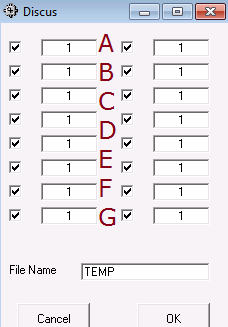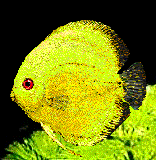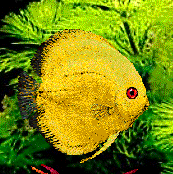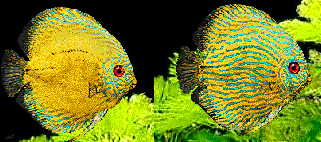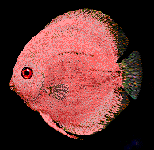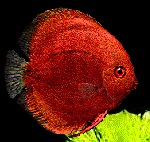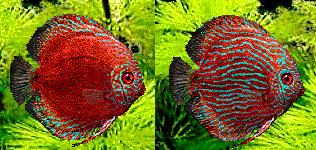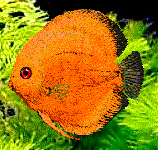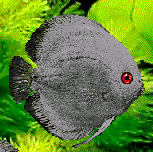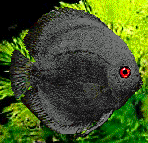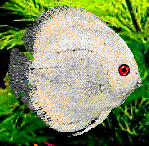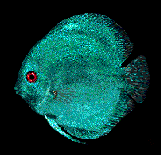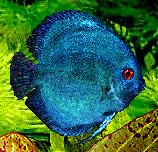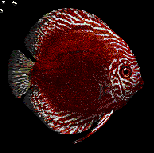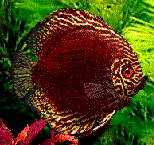Last time I spliced Discus genes, I only made it to line C before, if I’m honest, it was time for me to go to bed. Now that I’m back, it’s time to check out the other genes. I still haven’t found the genes that affect the Discus’ colors.
In case you forgot, here’s the box to show the rows I’m editing. Last time we stopped after C, today we’re finishing D through H, time allowing. Also, it turns out I goofed and miscounted the number of lines. My bad!
D
D 25
Yellow fish! Now we’re finally getting somewhere. Unless I’m mistaken, yellow is one of the two base colors with blue being the other. I’m only basing this on the two discus .fsh files that come with the addon pack. D 50 and D 75 produce the same result.
D 100
D 100 produces a much darker, more natural looking yellow. We’ll call it canary yellow. I was expecting the color to work in shades, depending on the ‘intensity’ of this gene but that isn’t the case.
Anyway, let’s see how D affects the colors from line A.
A 50 – A 100
D 50
Changing D doesn’t seem to affect the color of the stripes at all. Oh well.
B only affects the intensity of the stripes and C affects the intensity of vertical bars.
E
E 25 – 75
Ooh! Red seems like another base color. As with yellow, values 25, 50 and 75 produce the result above.
E 100
E 100 produces this gorgeous shade of red. Knowing what we do now about this gene, let’s see how it interacts with other genes.
A 50 – A 100
E 100
As above, B only affects the intensity of the stripes and C affects the intensity of vertical bars.
When I mix our two color genes, something very interesting happens. The colors blend! This is a gorgeous shade on its own already but, unfortunately, this is the only color we can get by mixing these genes. I don’t just mean orange, I mean this particular intensity is all we can get.
F
F 50
Ooh! This is a neat color. Of all the colors out there, grey was probably the last I expected to see. Let’s see what happens when I change the value to 100.
F 100
Black! We have a black discus now. Now that we know what this does to the fish’s base, let’s start mixing it with other genes.
All have F set to 50. In order from left to right.
A 50 – C 50 – D 50 – E 50 – D 50 E 50
Such pretty fish so far! But I’m still trying to figure out what changes the stripe color and eye color. Since I don’t know yet, let’s press on.
G
G 50
Do you remember what I was saying in line C where C and G work together to form bars on the fish? Turns out I misread the site. That’s not til the next line.
I edited the other genes we’ve tested and I still come up with no changes to the fish at all, not even to the color of the stripes, bars or eye of the fish. Frustrated, I did some additional research.
As it turns out, A and B set to 100produce a blue-green discus.
Changing G to 50 produces a darker blue. It’s difficult for me to agree with the game’s assessment that blue is a base color since it seems like blue acts more like an overlay color. Maybe they’re referring to the overlay color in the file names. Still, red and yellow are probably more fitting choices though it’s difficult to say that as well since the colors blend and work together. Changing G again to 100 produces the blue-green fish above. Changing A to 50 produces an albino fish with a Halo in dark blue instead of blue-green. Someday we’ll crack this. I found discus online with gold halos and I don’t seem to be able to produce that in FisherMan. I’m stubborn though!
After opening the Gene window in FisherMan, I found that there was a gene that I could not edit. Where my discus with a blue halo had a value of 1 for that gene, the discus I imported with golden halos had a value of 0. This gene, naturally is the second part of H. Even after going through each gene and chaning the values to 1-16, the 16th gene changes back to 1. 1 seems to be dominant.
Eventually, I loaded up a hex editor (in my case HxD, though ResHack works, too) and scrolled down to the bottom. To make it easy for me to spot the offending gene, I spliced some fish to have the numbers 1 through 16 as their genotype. Naturally, the 16th gene stayed 1. I scrolled down looking for the number sequence and voila!
There it was, the solution to my problem. The value was originally 01. I changed both fish so that the value was 0 and out came these lovelies (after some edits).
Isn’t that a lovely looking fish? How about we try to get gold? Above, G is set to 0. Let’s change it to 110 and see what happens.
Bam! G also seems to control eye color. It might be fair to call G an accent color modifier.
H
As I’d suspected, changing H by itself doesn’t actually change the appearance of the fish. Instead, it’s a modifier for the stripes and the vertical bars on the fish. If set to 0, it allows Gold and White stripes. If set to 4 it allows bars to appear on the fish in different intensities than one bar or full bars.
We already know that when you set C to 0, no bars appear on the fish. When you set it to 50 with H set to 1 or 0, the fish gets one bar over its eye.
In order from left to right, here are the combinations I used.
C 0 – C 50 H 1 – C 50 H 4 – C 80 H 4 – C 100
